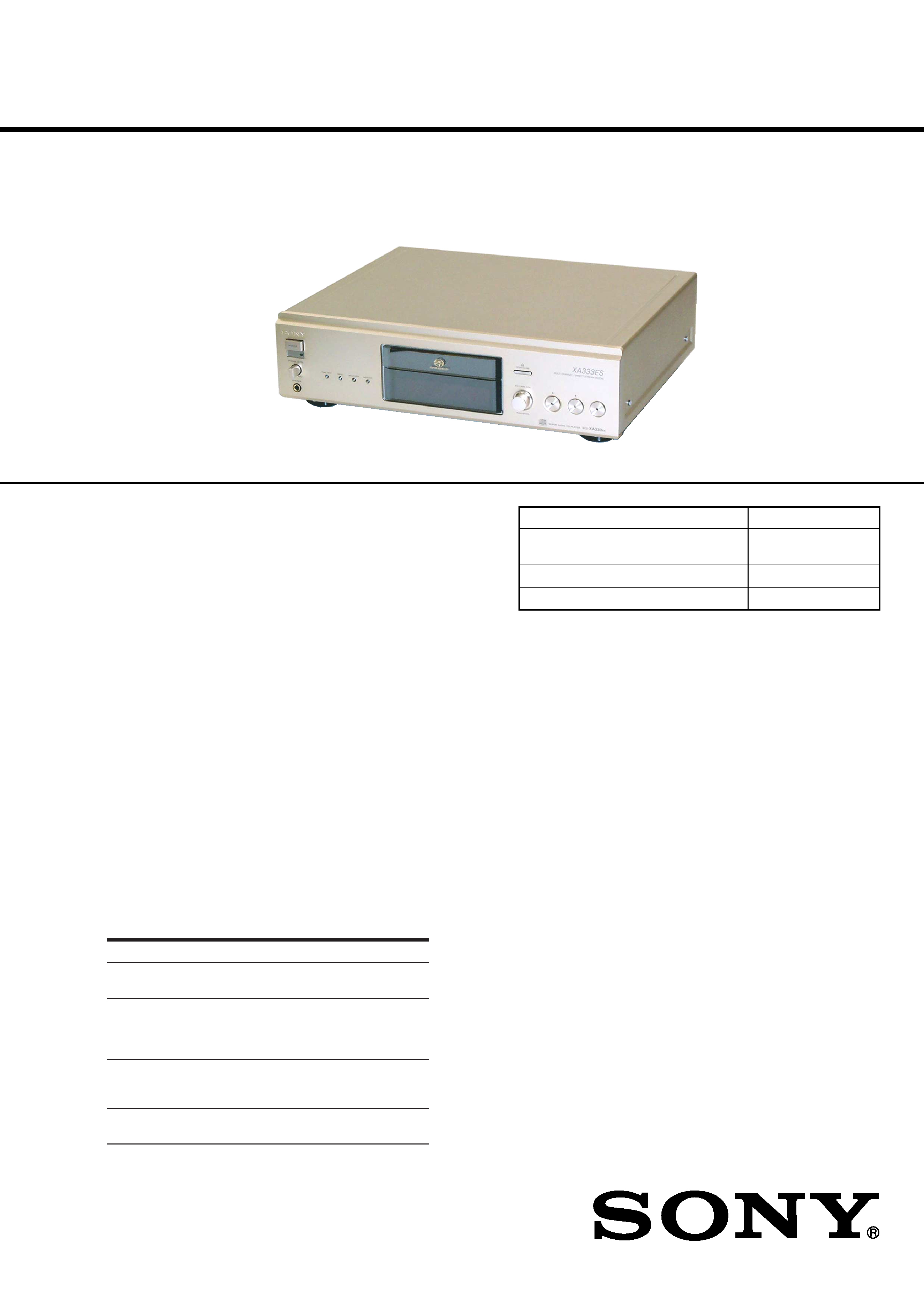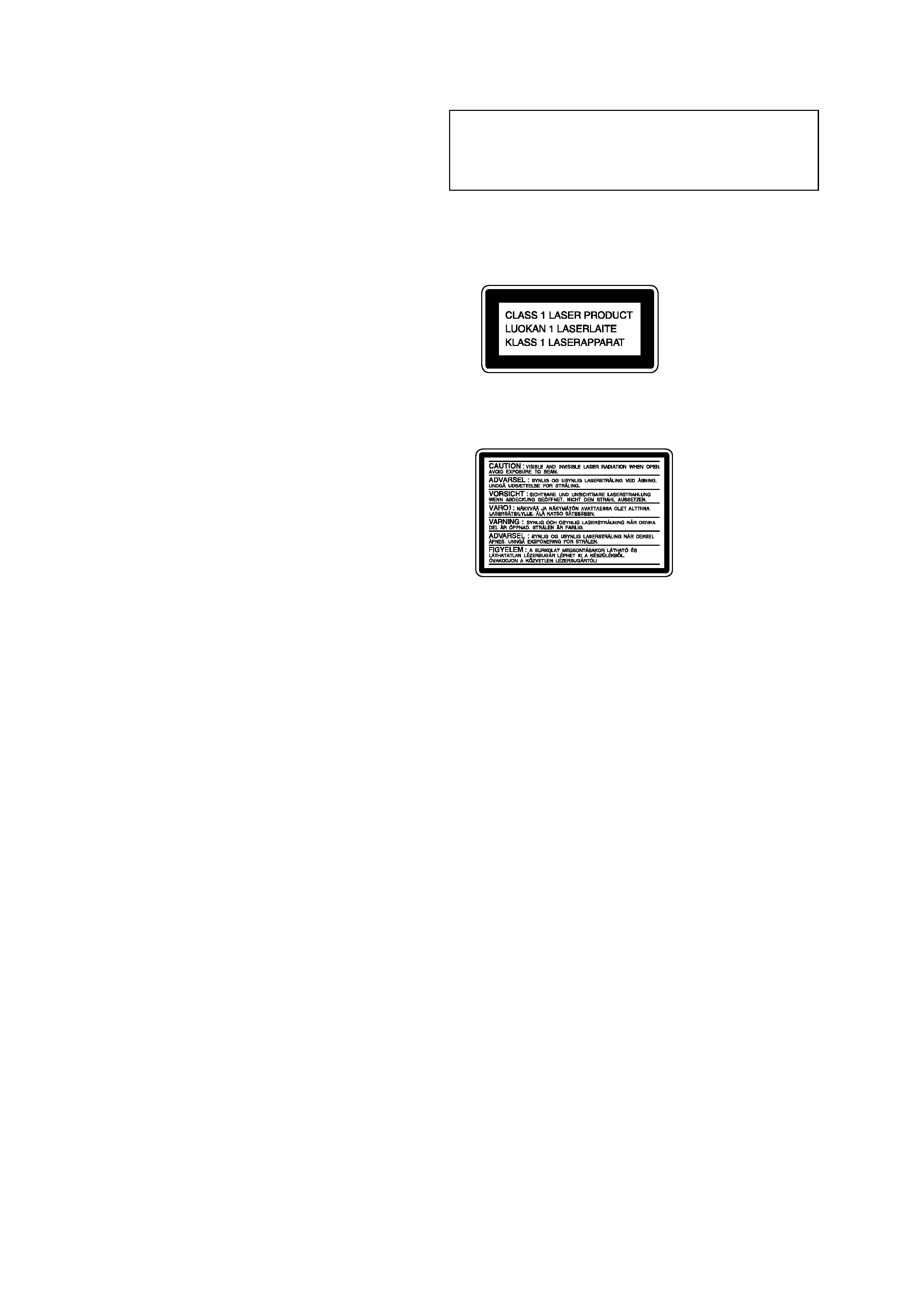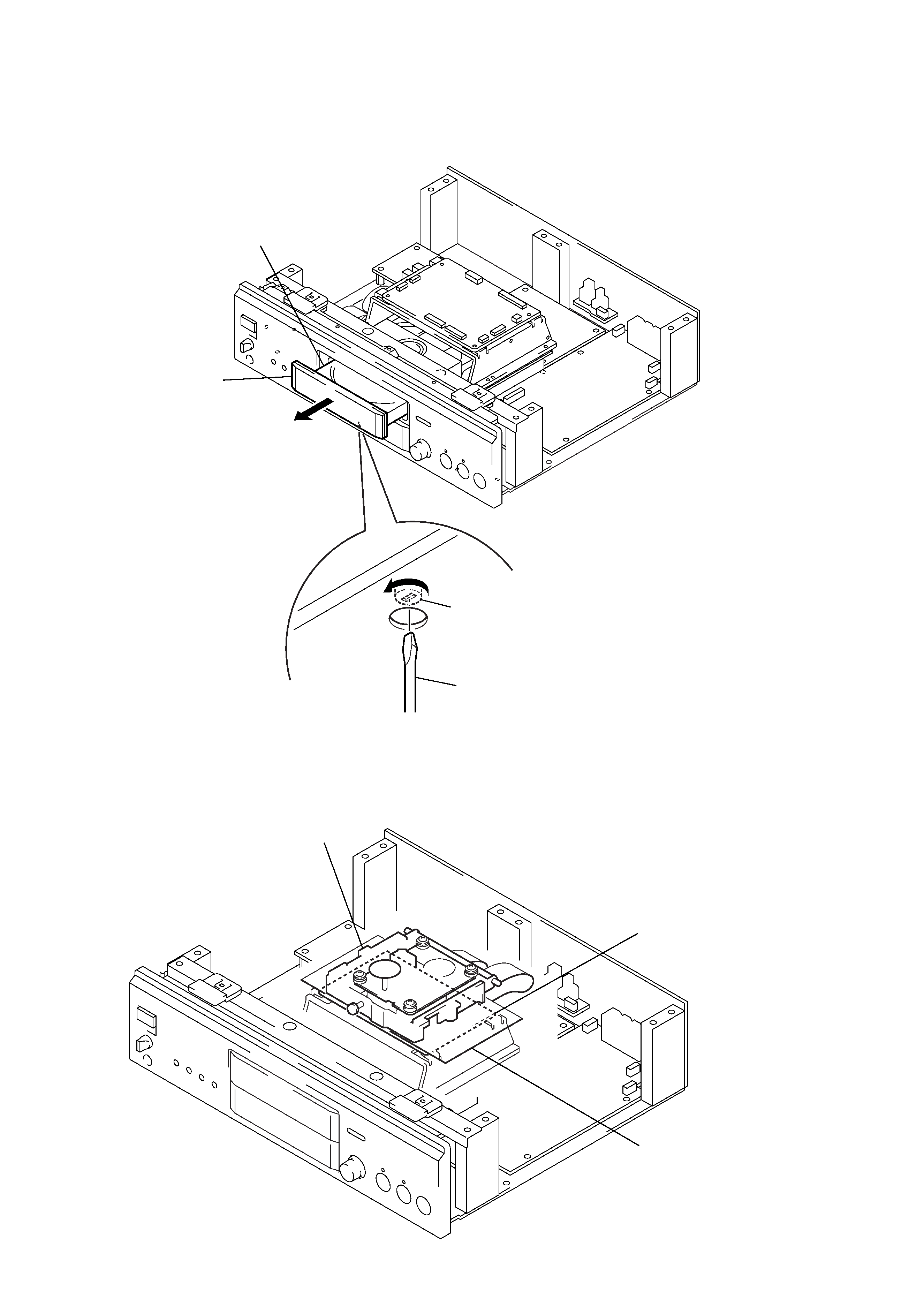
SERVICE MANUAL
Model Name Using Similar Mechanism NEW
CD Mechanism Type
CDM19IB-DVBU4B
CDM19IN-DVBU4B
Base Unit Name
DVBU4B
Optical Pick-up Name
KHM-230AAA
When a super audio CD is played
Playing frequency range
2 Hz to 100 kHz
Frequency response
2 Hz to 50 kHz (3 dB)
Dynamic range
106 dB or more
Total harmonic distortion rate
0.0015 % or less
Wow and flutter
Value of measurable limit (
±0.001 %
W. PEAK) or less
When a CD is played
Frequency response
2 Hz to 20 kHz
Dynamic range
100 dB or more
Total harmonic distortion rate
0.0018 % or less
Wow and flutter
Value of measurable limit (
±0.001 %
W. PEAK) or less
Output connector
*Output only the audio signals of the CD
General
Laser
Semiconductor laser
(SACD:
= 650 nm)
(CD:
= 780 nm)
Emission duration:continuous
Laser radiant power:
5.47 uW at 650 nm
*These output is the value measur ed at a distance of about
200mm from the objective lens surface on the optical pick-up.
Power requirements
230 V AC, 50/60 Hz
Power consumption
27 W
Dimensions (w/h/d)
430
× 130 × 380 mm
incl. projecting parts
Mass (approx.)
9.5 kg
Supplied accessories
Design and specifications are subject to change without
notice.
ANALOG OUT
DIGITAL(CD)
OUT
OPTICAL*
DIGITAL(CD)
OUT
COAXIAL*
PHONES
Jack type
Phono
jacks
Square
optical
output
connector
Coaxial
output
connector
Stereo
phone jack
Output level
2 Vrms
(at 50 kilohms)
18 dBm
0.5 Vp-p
10 mW
Load impedance
Over 10 kilohms
Lightemitting
wave length:
660 nm
75 ohms
32 ohms
(
)
· Audio connecting cord
phono jack
× 2 (Red and White) y phono jack × 2 (Red
and White) (2)
phono jack
× 1 (Black) y phono jack × 1 (Black) (2)
· Remote commander RM-SX700 (1)
· R06 (size-AA) batteries (2)
SUPER AUDIO CD PLAYER
AEP Model
SPECIFICATIONS
SCD-XA333ES
Photo: Gold type
Ver 1.0 2001.06
9-873-151-01
Sony Corporation
2001F0500-1
Home Audio Company
C
2001.6
Shinagawa Tec Service Manual Production Group

2
SCD-XA333ES
SAFETY-RELATED COMPONENT WARNING!!
COMPONENTS IDENTIFIED BY MARK 0 OR DOTTED
LINE WITH MARK 0 ON THE SCHEMATIC DIAGRAMS
AND IN THE PARTS LIST ARE CRITICAL TO SAFE
OPERATION. REPLACE THESE COMPONENTS WITH
SONY PARTS WHOSE PART NUMBERS APPEAR AS
SHOWN IN THIS MANUAL OR IN SUPPLEMENTS PUB-
LISHED BY SONY.
Notes on chip component replacement
· Never reuse a disconnected chip component.
· Notice that the minus side of a tantalum capacitor may be dam-
aged by heat.
Flexible Circuit Board Repairing
· Keep the temperature of the soldering iron around 270 °C dur-
ing repairing.
· Do not touch the soldering iron on the same conductor of the
circuit board (within 3 times).
· Be careful not to apply force on the conductor when soldering
or unsoldering.
TABLE OF CONTENTS
1.
SERVICING NOTES ............................................... 3
2.
GENERAL ................................................................... 6
3.
DISASSEMBLY
3-1. Disassembly flow ............................................................
9
3-2. Case .................................................................................
9
3-3. Loading Panel Assy ......................................................... 10
3-4. Front Panel Section ......................................................... 10
3-5. MAIN Board ................................................................... 11
3-6. Mechanism Deck (CDM19IB-DVBU4B,
CDM19IN-DVBU4B), RF Board ................................... 11
3-7. Disc Table, Belt, Loading Motor (M1) ........................... 12
3-8. Optical Device (KHM-230AAA) ................................... 12
3-9. Base Unit (DVBU4B) ..................................................... 13
4.
TEST MODE .............................................................. 14
5.
DIAGRAMS
5-1. Block Diagram RF/SERVO Section ........................ 28
5-2. Block Diagram MAIN Section (1/2) ....................... 29
5-3. Block Diagram MAIN Section (2/2) ....................... 30
5-4. Block Diagram AUDIO Section .............................. 31
5-5. Block Diagram
DISPLAY/POWER SUPPLY Section ...................... 32
5-6. Note for Printed Wiring Boards and
Schematic Diagrams ....................................................... 33
5-7. Printed Wiring Boards
LOADING MOTOR/RF/SWITCH Boards .............. 34
5-8. Schematic Diagram
LOADING MOTOR/RF/SWITCH Boards .............. 35
5-9. Printed Wiring Board
MAIN Board (Component Side) .............................. 36
5-10. Printed Wiring Board
MAIN Board (Conductor Side) ................................ 37
5-11. Schematic Diagram MAIN Board (1/5) .................. 38
5-12. Schematic Diagram MAIN Board (2/5) .................. 39
5-13. Schematic Diagram MAIN Board (3/5) .................. 40
5-14. Schematic Diagram MAIN Board (4/5) .................. 41
5-15. Schematic Diagram MAIN Board (5/5) .................. 42
5-16. Printed Wiring Board
AUDIO Board (Component Side) ............................ 44
5-17. Printed Wiring Board
AUDIO Board (Conductor Side) ............................. 45
5-18. Schematic Diagram AUDIO Board (1/2) ................ 46
5-19. Schematic Diagram AUDIO Board (2/2) ................ 47
5-20. Printed Wiring Board DISPLAY Board ................... 48
5-21. Schematic Diagram DISPLAY Board ..................... 49
5-22. Printed Wiring Boards D.OUT/ HP Boards ............ 50
5-23. Schematic Diagram D.OUT/ HP Boards ................. 50
5-24. Printed Wiring Boards
JOG/KEY/R.CNTL Boards ...................................... 51
5-25. Schematic Diagram JOG/KEY/R.CNTL Boards .... 51
5-26. Printed Wiring Boards
IC-1/IC-2/POWER Boards ....................................... 52
5-27. Schematic Diagram IC-1/IC-2/POWER Boards ..... 53
5-28. Printed Wiring Boards AC/AC SW Boards ............. 54
5-29. Schematic Diagram AC/AC SW Boards ................. 54
5-30. IC Pin Function Description ........................................... 61
6.
EXPLODED VIEWS
6-1. Case section ..................................................................... 76
6-2. Front Panel Section ......................................................... 77
6-3. Chassis Section-1 ............................................................ 78
6-4. Chassis Section-2 ............................................................ 79
6-5. Mechanism Deck Section
(CDM19IB-DVBU4B, CDM19IN-DVBU4B ) .............. 80
6-6. Base Unit Section (DVBU4B) ........................................ 81
7.
ELECTRICAL PARTS LIST ............................... 82
CAUTION
Use of controls or adjustments or performance of procedures
other than those specified herein may result in hazardous ra-
diation exposure.
This appliance is classified as a CLASS 1
LASER product.
The CLASS 1 LASER PRODUCT
MARKING is located on the rear exterior.
The following caution label is located
inside the unit.

3
SCD-XA333ES
SECTION 1
SERVICING NOTES
The laser diode in the optical pick-up block may suffer electro-
static break-down because of the potential difference generated
by the charged electrostatic load, etc. on clothing and the human
body.
During repair, pay attention to electrostatic break-down and also
use the procedure in the printed matter which is included in the
repair parts.
The flexible board is easily damaged and should be handled with
care.
NOTES ON LASER DIODE EMISSION CHECK
The laser beam on this model is concentrated so as to be focused
on the disc reflective surface by the objective lens in the optical
pick-up block. Therefore, when checking the laser diode emis-
sion, observe from more than 30 cm away from the objective lens.
CLEANING OF OPTICAL PICK-UP LENS
In cleaning the lens of optical pick-up, use the air blower.
Never use a cotton swab for cleaning the lens of optical pick-up,
which otherwise causes a trouble.
RESETTING OPERATION AT POWER ON
If the power is turned on with a disc loaded in the set, a sequence
of operation as shown below will be performed.
(The operation varies depending on the type of disc)
Condition: continue mode
(1) CD
1.
Sled reverse move (sled in)
2.
Disc detect
3.
IC setting for CD
4.
Servo error signal offset auto adjustment
5.
Spindle kick for LD on
6.
LD on
7.
Focus search
8.
Focus servo on
9.
Spindle kick
10. Spindle servo on
11. E-F balance auto adjustment
12. Tracking & sled servo on
13. Focus bias auto adjustment
14. Focus servo gain auto adjustment
15. Tracking servo gain auto adjustment
16. Jump to lead-in area
17. Read TOC
18. Stop
NOTES ON HANDLING THE OPTICAL PICK-UP
BLOCK OR BASE UNIT
(2) SACD (single layer)
1.
Sled reverse move (sled in)
2.
Disc detect
3.
IC setting for SACD
4.
Servo error signal offset auto adjustment
5.
Spindle kick for LD on
6.
LD on
7.
Focus search
8.
Focus servo on
9.
Spindle kick
10. Spindle servo on
11. E-F balance auto adjustment
12. Tracking & sled servo on
13. Focus bias auto adjustment
14. Focus servo gain auto adjustment
15. Tracking servo gain auto adjustment
16. Jump to lead-in area
17. Read TOC
18. Stop
(3) SACD (dual layer)
1.
Sled reverse move (sled in)
2.
Disc detect
3.
IC setting for SACD
4.
Servo error signal offset auto adjustment
5.
Spindle kick for LD on
6.
LD on
7.
Focus search
8.
Focus servo on (layer 0)
9.
Spindle kick
10. Spindle servo on
11. E-F balance auto adjustment (layer 0)
12. Tracking & sled servo on (layer 0)
13. Focus bias auto adjustment (layer 0)
14. Focus servo gain auto adjustment (layer 0)
15. Tracking servo gain auto adjustment (layer 0)
16. Jump to lead-in area
17. Read TOC
18. Focus jump (layer 0
tlayer 1)
19. E-F balance auto adjustment (layer 1)
20. Tracking & sled servo on (layer 1)
21. Focus bias auto adjustment (layer 1)
22. Focus servo gain auto adjustment (layer 1)
23. Tracking servo gain auto adjustment (layer 1)
24. Focus Jump (layer 1
tlayer 0)
25. Stop

4
SCD-XA333ES
HOW TO OPEN THE DISC TABLE WHEN POWER SWITCH TURNS OFF
disc table
loading panel assy
tapering driver
cover (CAM)
2
Draw out the loading panel assy
in the direction of arrow B.
1
Insert a tapering driver in the hole
at the bottom of the unit,
turn the cover (CAM) fully in the
direction of arrow A.
B
A
OPTICAL PICK-UP SERVICE POSITION
Place the insulator on the MAIN board, then install the base unit (DVBU4B) on it as shown in the figure.
base unit
(DVBU4B)
MAIN board
insulator

5
SCD-XA333ES
CABLE SETTING
When connecting the cable from transformer to POWER board, set it as shown in the figure.
CN452
POWER board
clamp wire
CN422
CN401
transformer
